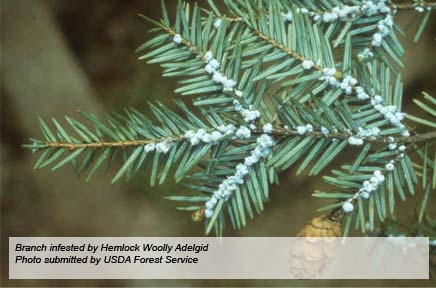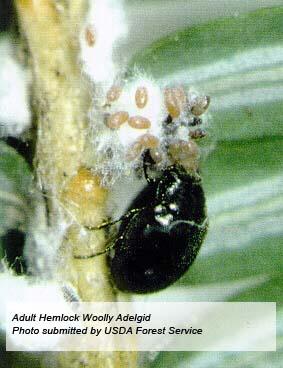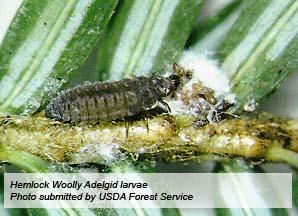Early Find Could Protect Hemlock Trees and Kentucky Forests
Early Find Could Protect Hemlock Trees and Kentucky Forests


University of Kentucky College of Agriculture Entomologist Lee Townsend calls the early find of hemlock wooly adelgid on hemlock trees in Harlan county a “major piece of luck.”
Each year, the College of Agriculture monitors traps set to find another devastating insect, the gypsy moth. In the spring, gypsy moth trappers were enlisted to help find the hemlock wooly adelgid, which could devastate the state’s hemlock trees and as a result, radically change the ecology of Kentucky forests. Fortunately one of the trappers successfully detected an early infestation of the adelgid in southeastern Kentucky in April.
“We’ve seen what can happen in the Northeast and in the Smokies when it was discovered later,” Townsend said. “We are in, what I think is, the very first part of the infestation and have a chance to at least try to make an impact in reducing what the insect can do, particularly around the tree stands more people are using for recreation and also for some of the really old trees that have an impact on the history of the ecology of the area.”
Recently Townsend and several colleagues provided training about the adelgid to county Cooperative Extension Service agents, forest industry professionals, state forest officials, homeowners and others at the Pine Mountain Settlement School and at the Extension office in Harlan County. They taught participants how to spot the insect and how to combat it. “We’ve done this type of training with several different types of pests,” Townsend said. “On average, every two years there’s a new pest. A great thing about our system is that we have access to research and we have a mechanism to get information to a tremendous number of people in a short time. Already we have two dozen people who are trained on how to look for the hemlock adelgid. They know how to take samples, and I’m confident those people will multiply their efforts and I think we’ll end up with not only a good handle on the infestation, but also a better picture of hemlock forests in Kentucky.”
“We’ve done this type of training with several different types of pests,” Townsend said. “On average, every two years there’s a new pest. A great thing about our system is that we have access to research and we have a mechanism to get information to a tremendous number of people in a short time. Already we have two dozen people who are trained on how to look for the hemlock adelgid. They know how to take samples, and I’m confident those people will multiply their efforts and I think we’ll end up with not only a good handle on the infestation, but also a better picture of hemlock forests in Kentucky.”
After the initial adelgid find in the spring, Harlan County Extension Agent for Agriculture and Natural Resources Jeremy Williams said he found what he thought was an adelgid near the Pine Mountain Settlement School.
“I was here with a group giving a tour; we were just walking along and I looked over into a hemlock tree and there it was,” Williams recalled. “It was almost like it was staring at me saying ‘I’m here.’ They originally found it on the south side of the mountain, but I found it at the Settlement School. … I knew what it looked like so I immediately contacted folks in entomology and they came out and confirmed it was the adelgid.”
Hemlock trees are found in riparian zones along streams and are very important in regulating the characteristics of a watershed, such as stream temperature and sedimentation. They are also important to all the organisms associated with a stream.
UK Forest Entomologist Lynne Rieske-Kinney said an adelgid infestation could affect entire ecosystems in eastern Kentucky forests.
“It would be as noticeable, and more devastating, as the effects of the southern pine beetle,” she said. “Adelgid-infested branches start to fade in color and then the needles drop. Small branches die back and then larger ones. Before too long, if it’s left unchecked, the entire tree will die and you’ll have a standing skeleton of a hemlock tree. The adelgid is lethal to hemlock, and hemlocks are very slow to regenerate. The hemlock is not considered an important timber tree, but it’s incredibly important ecologically and it plays a critical role as a resource for wildlife and regulating stream temperature and stream quality in watersheds. Hemlocks evoke tremendous emotion in people. People love hemlock trees and rightfully so, hemlock trees are gorgeous.” After the find of the wooly adelgid in Harlan County, officials took action to help halt the spread of the pest. The soil surrounding most of the infested trees was injected with an insecticide designed to kill the adelgid. After the injection they followed through with a foliar spray treatment. The initial treatment was the first of April and in June they came through with the foliar spray, Rieske-Kinney said
After the find of the wooly adelgid in Harlan County, officials took action to help halt the spread of the pest. The soil surrounding most of the infested trees was injected with an insecticide designed to kill the adelgid. After the injection they followed through with a foliar spray treatment. The initial treatment was the first of April and in June they came through with the foliar spray, Rieske-Kinney said
“The initial treatment was a soil injection with an insecticide that’s translocated – taken up by the roots of the plant – to the foliage. We followed up with insecticidal soap three to four weeks after the injection. The trees that received both are doing well. The area of concern is what we didn’t inject and what we couldn’t reach with the foliar sprays.”
Williams said he is hopeful that by training people to look for the adelgid, everyone can help stop its spread.
“I hope the folks that were here at the training gain knowledge and they are more eyes out there and take it to the public they work with everyday,” he said.
